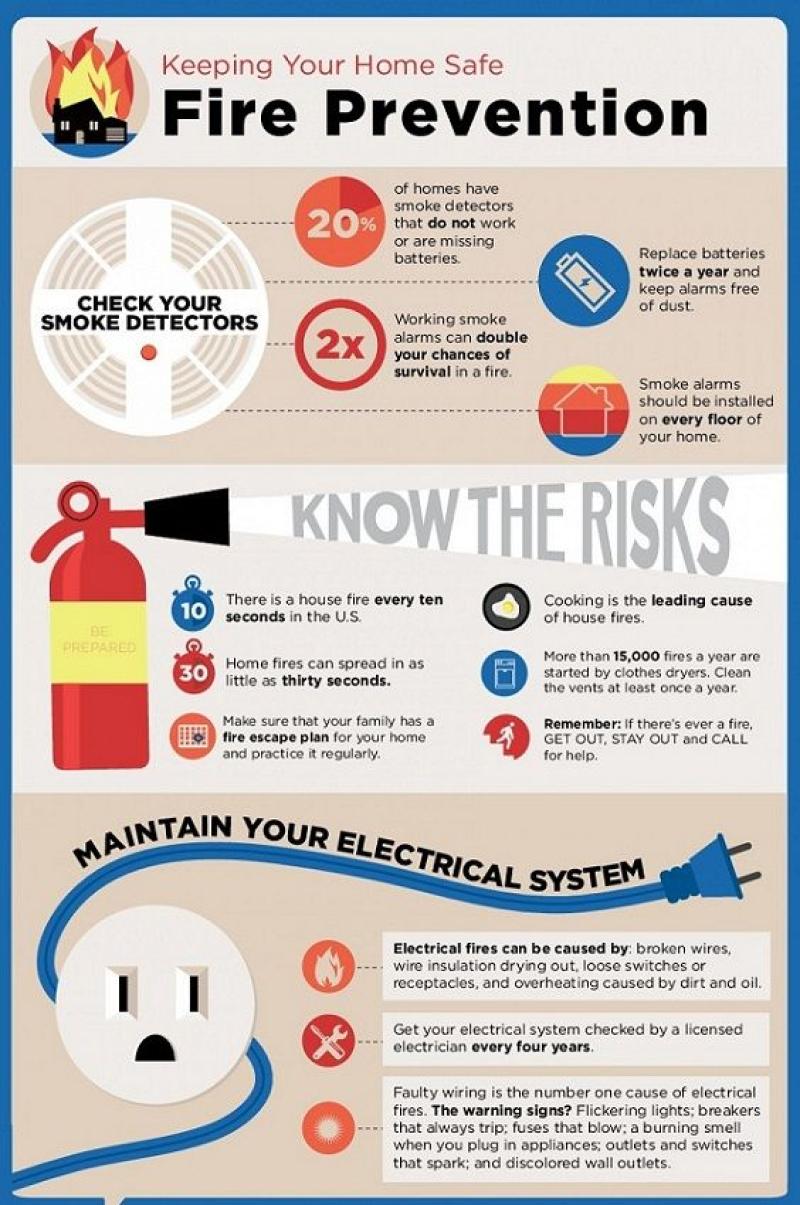What do you need to know about fire safety?
Understanding the essentials of fire safety is crucial for individuals in various settings, including homes, workplaces, and public spaces. Here are key pieces of information and practices you need to know about fire safety:
1. Fire Prevention:
Hazard Identification: Be aware of potential fire hazards in your environment. This includes identifying sources of heat, flammable materials, and electrical equipment.
Proper Storage: Store flammable materials safely, away from heat sources. Follow guidelines for storing combustible materials in homes and workplaces.
Smoking Safety: If smoking is allowed, use designated areas and dispose of cigarette butts in proper containers. Avoid smoking in bed or in areas with flammable materials.
Electrical Safety: Follow electrical safety practices, such as avoiding overloading outlets, using certified electrical appliances, and promptly addressing faulty wiring.
Cooking Safety: Practice safe cooking habits, including never leaving cooking unattended, keeping flammable items away from heat sources, and using kitchen appliances responsibly.
2. Fire Detection:
Smoke Alarms: Install smoke alarms in key areas of your home or workplace, including bedrooms and hallways. Test alarms monthly and replace batteries at least once a year.
Fire Detection Systems: In larger buildings, ensure the presence and proper functioning of fire detection systems, including fire alarms and sprinklers.
3. Emergency Planning:
Escape Routes: Know the escape routes in your home or workplace. Establish primary and alternative routes in case of blocked exits.
Emergency Exits: Identify and familiarize yourself with emergency exits in buildings. Keep exits clear of obstructions.
Evacuation Plans: Develop and practice evacuation plans, including assembly points outside the building. Conduct regular fire drills to ensure everyone knows what to do in case of a fire.
4. Firefighting Equipment:
Fire Extinguishers: Learn how to use a fire extinguisher. Keep extinguishers accessible and ensure they are in good working condition.
Fire Hoses and Hydrants: In larger buildings, familiarize yourself with the location of fire hoses and hydrants. Know how to use them in case of a fire emergency.
5. Training and Education:
Fire Safety Training: Participate in fire safety training programs offered by your workplace or community. Learn about fire prevention, emergency response, and evacuation procedures.
First Aid Training: Acquire basic first aid skills to provide assistance in case of injuries during a fire emergency.
6. Communication:
Emergency Numbers: Know the emergency numbers for your region, including the local fire department. Keep these numbers easily accessible.
Communication Plans: Establish communication plans for notifying occupants and emergency services during a fire. Use loudspeakers, intercoms, or other communication systems.
7. Fire Safety Regulations:
Compliance: Adhere to local, state, and national fire safety regulations. Ensure that buildings and facilities meet applicable codes and standards.
Inspections: Conduct regular inspections of fire safety equipment, emergency exits, and other safety features to ensure compliance and functionality.
8. Fire Safety Equipment Maintenance:
Regular Inspections: Periodically inspect and maintain fire safety equipment, including alarms, extinguishers, and sprinkler systems.
Professional Services: Engage qualified professionals for periodic inspections and maintenance of specialized fire safety systems.
9. Communication:
Emergency Communication Systems: Establish effective communication systems for alerting occupants during an emergency. This may include loudspeakers, intercoms, or other notification methods.
Emergency Contacts: Maintain a list of emergency contacts, including local fire departments and other relevant authorities.
10. Fire Safety for Children:
Educate Children: Teach children about the basics of fire safety, including the dangers of playing with matches or lighters. Establish family evacuation plans.
Practice Drills: Conduct fire drills at home to ensure that everyone, including children, knows what to do in case of a fire emergency.
11. Emergency Services Coordination:
- Coordination with Emergency Services: Establish communication and coordination with local emergency services. Provide clear information about the location and nature of the emergency.
12. Continuous Improvement:
- Learn from Incidents: After fire incidents or drills, review the response to identify areas for improvement. Update emergency plans based on lessons learned.
13. Personal Responsibility:
- Be Vigilant: Take personal responsibility for fire safety. Report potential hazards, follow safety guidelines, and contribute to maintaining a fire-safe environment.
Understanding and implementing these fire safety essentials can significantly reduce the risk of fire incidents and contribute to a safer living and working environment. Regular training, awareness, and preparedness are key components of effective fire safety practices.
Fundamental Aspects of Fire Safety
Fire safety encompasses a wide range of knowledge and skills, but some fundamental aspects are crucial for everyone to understand:
1. Fire Triangle:
- Fuel: Combustible materials like wood, paper, and clothing feed the fire.
- Heat: An ignition source provides the heat required to start and sustain the fire.
- Oxygen: Fire requires oxygen to burn.
Removing or interrupting any of these elements will extinguish the fire.
2. Types of Fires:
Understanding different types of fires helps choose the appropriate extinguishing method:
- Class A: Ordinary combustibles like paper, wood, and textiles.
- Class B: Flammable liquids like gasoline, grease, and oil.
- Class C: Electrical fires.
- Class D: Combustible metals like magnesium and titanium.
- Class K: Kitchen fires involving cooking oils and grease.
3. Fire Extinguishers:
Knowing how to use different types of fire extinguishers effectively is critical:
- Class A: Water or multi-purpose extinguishers.
- Class B: Dry chemical or carbon dioxide extinguishers.
- Class C: Non-conductive extinguishers like carbon dioxide or dry chemical.
- Class D: Specialized extinguishers suitable for specific metal types.
- Class K: Wet chemical extinguishers designed for kitchen fires.
4. Evacuation Plans and Procedures:
Having a clear plan and practicing evacuation procedures regularly ensure everyone knows what to do in case of a fire:
- Identify multiple escape routes from each room.
- Designate a meeting place outside the building.
- Practice evacuation drills regularly.
- Assist individuals with disabilities during evacuation.
5. Fire Prevention:
Taking preventive measures can significantly reduce the risk of fire:
- Don't overload electrical outlets.
- Properly dispose of flammable materials and oily rags.
- Keep flammable materials away from heat sources.
- Install working smoke alarms and carbon monoxide detectors.
- Develop a household fire safety plan.
Benefits of Comprehensive Fire Safety Knowledge
Understanding fire safety benefits individuals and communities in several ways:
- Reduces risk of fire-related injuries and deaths: Knowledge of fire hazards and safe practices helps prevent fires from occurring and minimizes damage if they do happen.
- Protects property and belongings: Understanding how to extinguish small fires can prevent them from spreading and causing extensive damage.
- Promotes a culture of safety: When individuals are knowledgeable about fire safety, they are more likely to take precautions and encourage others to do the same.
- Increases community preparedness: A community with a strong understanding of fire safety is better equipped to respond to emergencies and minimize the impact of fires.
Common Misconceptions about Fire Safety
Several misconceptions about fire safety can hinder effective prevention and response:
- Water can extinguish any fire: While water is effective for Class A fires, it can be dangerous for electrical fires or flammable liquids.
- Smoke alarms are not necessary: Smoke alarms are essential for early detection of fire and provide valuable time to escape.
- Fire extinguishers can put out any fire: Fire extinguishers are limited in size and effectiveness. Knowing the appropriate type and limitations is crucial.
- Opening windows helps put out a fire: This can actually provide more oxygen to the fire and make it worse.
- Hiding is a good option during a fire: It is always better to evacuate a burning building than to stay hidden.
By understanding these misconceptions and acquiring accurate knowledge about fire safety, individuals and communities can significantly enhance their preparedness and minimize the risk of fire-related tragedies.













